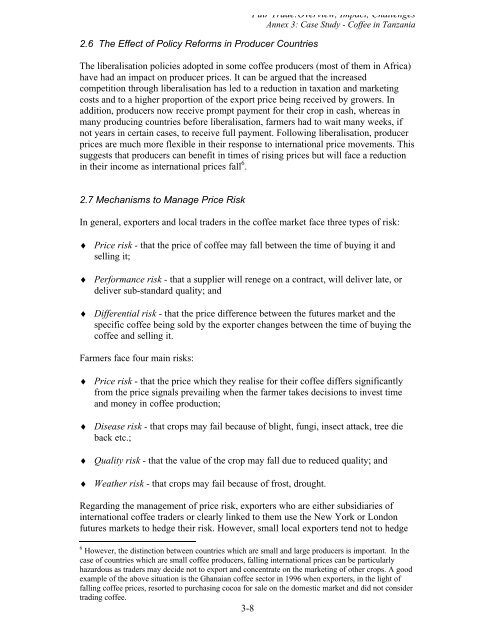Fair Trade: Overview, Impact, Challenges - Are you looking for one ...
Fair Trade: Overview, Impact, Challenges - Are you looking for one ...
Fair Trade: Overview, Impact, Challenges - Are you looking for one ...
Create successful ePaper yourself
Turn your PDF publications into a flip-book with our unique Google optimized e-Paper software.
2.6 The Effect of Policy Re<strong>for</strong>ms in Producer Countries<br />
<strong>Fair</strong> <strong>Trade</strong>:<strong>Overview</strong>, <strong>Impact</strong>, <strong>Challenges</strong><br />
Annex 3: Case Study - Coffee in Tanzania<br />
The liberalisation policies adopted in some coffee producers (most of them in Africa)<br />
have had an impact on producer prices. It can be argued that the increased<br />
competition through liberalisation has led to a reduction in taxation and marketing<br />
costs and to a higher proportion of the export price being received by growers. In<br />
addition, producers now receive prompt payment <strong>for</strong> their crop in cash, whereas in<br />
many producing countries be<strong>for</strong>e liberalisation, farmers had to wait many weeks, if<br />
not years in certain cases, to receive full payment. Following liberalisation, producer<br />
prices are much more flexible in their response to international price movements. This<br />
suggests that producers can benefit in times of rising prices but will face a reduction<br />
in their income as international prices fall 6 .<br />
2.7 Mechanisms to Manage Price Risk<br />
In general, exporters and local traders in the coffee market face three types of risk:<br />
♦ Price risk - that the price of coffee may fall between the time of buying it and<br />
selling it;<br />
♦ Per<strong>for</strong>mance risk - that a supplier will renege on a contract, will deliver late, or<br />
deliver sub-standard quality; and<br />
♦ Differential risk - that the price difference between the futures market and the<br />
specific coffee being sold by the exporter changes between the time of buying the<br />
coffee and selling it.<br />
Farmers face four main risks:<br />
♦ Price risk - that the price which they realise <strong>for</strong> their coffee differs significantly<br />
from the price signals prevailing when the farmer takes decisions to invest time<br />
and m<strong>one</strong>y in coffee production;<br />
♦ Disease risk - that crops may fail because of blight, fungi, insect attack, tree die<br />
back etc.;<br />
♦ Quality risk - that the value of the crop may fall due to reduced quality; and<br />
♦ Weather risk - that crops may fail because of frost, drought.<br />
Regarding the management of price risk, exporters who are either subsidiaries of<br />
international coffee traders or clearly linked to them use the New York or London<br />
futures markets to hedge their risk. However, small local exporters tend not to hedge<br />
6<br />
However, the distinction between countries which are small and large producers is important. In the<br />
case of countries which are small coffee producers, falling international prices can be particularly<br />
hazardous as traders may decide not to export and concentrate on the marketing of other crops. A good<br />
example of the above situation is the Ghanaian coffee sector in 1996 when exporters, in the light of<br />
falling coffee prices, resorted to purchasing cocoa <strong>for</strong> sale on the domestic market and did not consider<br />
trading coffee.<br />
3-8
















![CynefinFramework final [Read-Only]](https://img.yumpu.com/19017304/1/190x135/cynefinframework-final-read-only.jpg?quality=85)